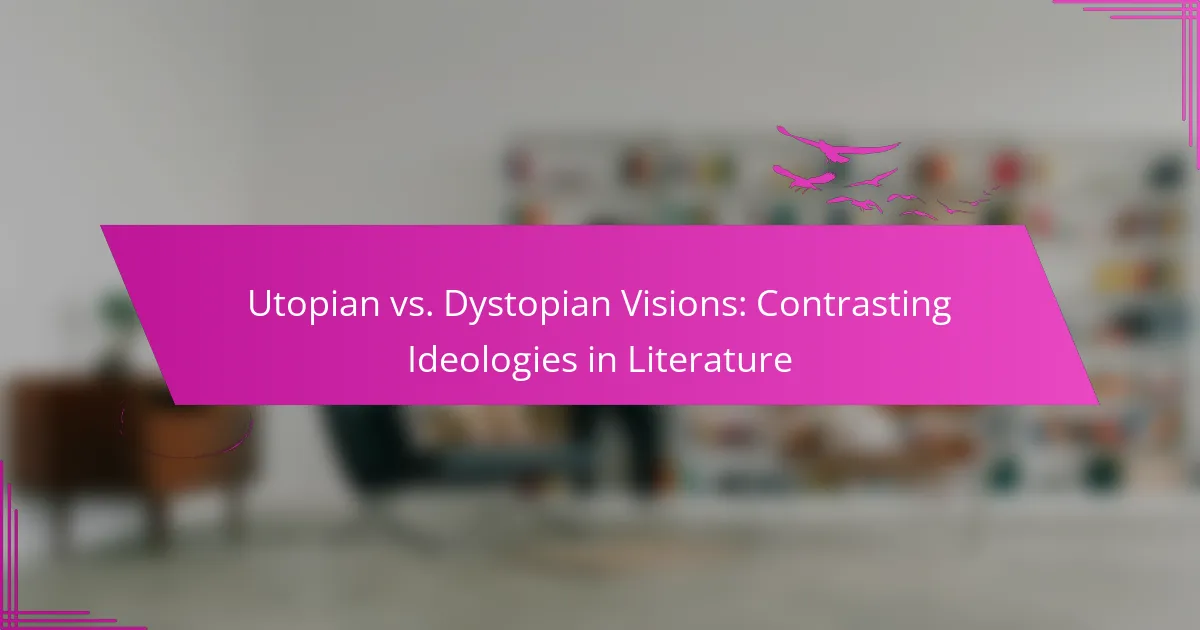Utopian and dystopian visions in literature reveal societal values and concerns about human progress. This article explores how utopian narratives embody ideals of harmony and equality, while dystopian works warn against authoritarianism and societal decay. It examines the historical influences shaping these contrasting ideologies, their psychological impacts on readers, and the critical insights they offer into contemporary societal debates. Notable authors like George Orwell and Aldous Huxley illustrate these themes through their compelling narratives.
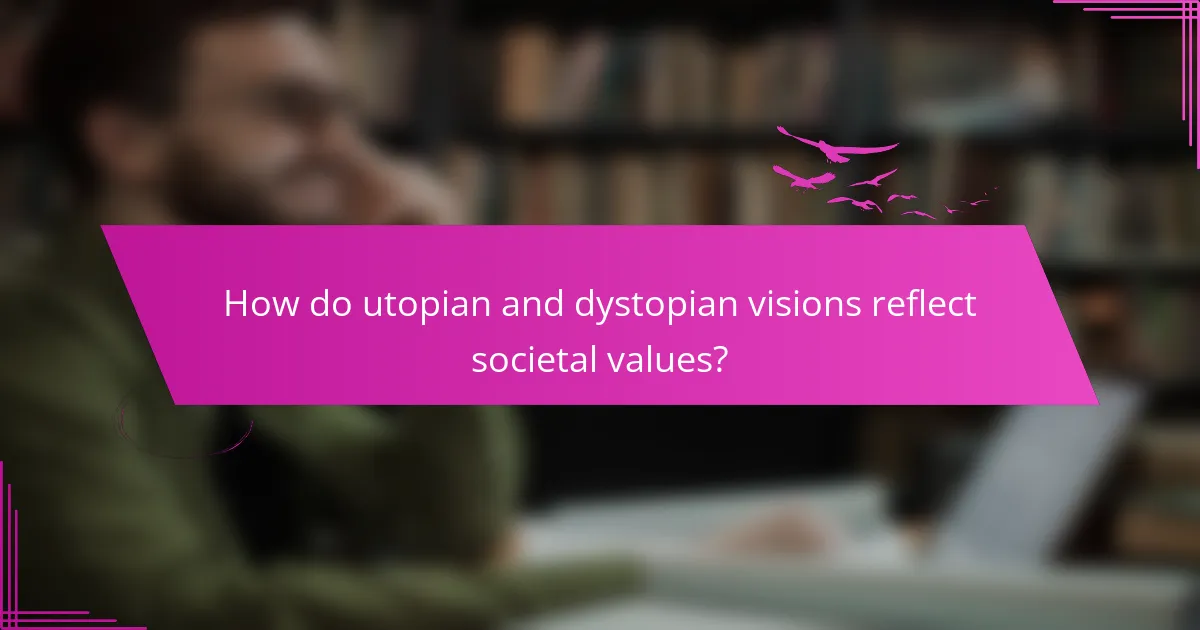
How do utopian and dystopian visions reflect societal values?
Utopian and dystopian visions reflect societal values by illustrating hopes and fears regarding human progress. Utopian narratives often embody ideals of harmony, equality, and prosperity, showcasing aspirations for a better future. In contrast, dystopian works highlight societal anxieties, warning against totalitarianism, environmental collapse, and technological overreach.
These contrasting ideologies serve as mirrors, revealing the collective consciousness of a society at a given time. Utopian visions may emerge in periods of optimism, while dystopian tales often arise during times of crisis or uncertainty. Both genres challenge readers to reflect on current values and the potential consequences of societal choices.
For example, George Orwell’s “1984” critiques authoritarianism, while Aldous Huxley’s “Brave New World” warns against consumerism and loss of individuality. These narratives provoke discussions about freedom, morality, and the human condition, ultimately influencing societal values and aspirations.
What are the defining characteristics of utopian literature?
Utopian literature is characterized by idealized societies that embody perfection in social, political, and economic structures. These narratives often explore themes of harmony, equality, and the pursuit of happiness. They contrast with dystopian literature, which highlights the flaws and consequences of oppressive systems. Utopian works frequently present unique attributes, such as innovative governance models or advanced technologies, that challenge existing norms. By envisioning an ideal future, these narratives inspire readers to reflect on present realities and consider transformative possibilities.
What are the defining characteristics of dystopian literature?
Dystopian literature is characterized by oppressive societal control, often through totalitarian regimes, loss of individuality, and environmental degradation. It explores themes of surveillance, censorship, and the consequences of technological advancements. The narratives typically depict bleak futures, highlighting human suffering and moral dilemmas. Unique attributes include the portrayal of flawed utopias that serve as warnings against current societal trends.
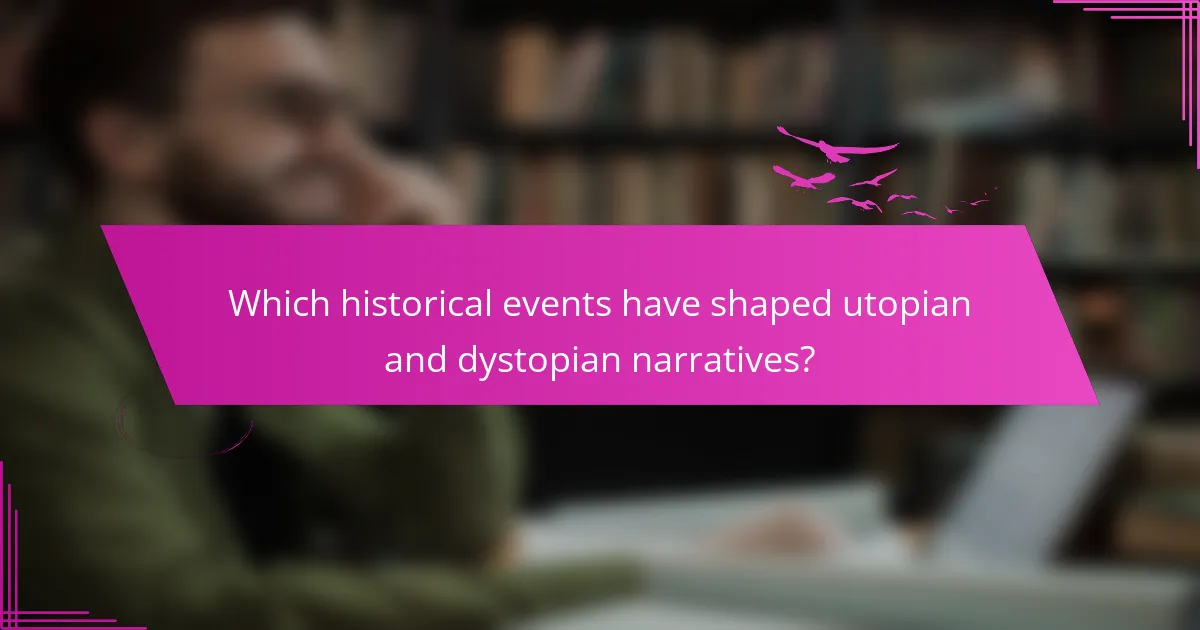
Which historical events have shaped utopian and dystopian narratives?
Historical events such as the Industrial Revolution and World Wars have significantly influenced utopian and dystopian narratives. The Industrial Revolution, marked by rapid technological advancement, inspired visions of progress and societal improvement. Conversely, the devastation of World Wars led to dystopian themes, reflecting fears of totalitarianism and societal collapse. The Cold War further shaped these narratives, highlighting ideological conflicts and the threat of nuclear annihilation. These events illustrate how societal fears and aspirations manifest in literature, creating contrasting ideologies that explore the human condition.
How do different cultural contexts influence the portrayal of utopian ideals?
Cultural contexts significantly shape the portrayal of utopian ideals in literature. Different societies project their values, fears, and aspirations through unique narratives, influencing how utopia is envisioned.
For instance, Western literature often reflects individualism and technological advancement, while Eastern narratives may emphasize community and harmony with nature. These cultural lenses create distinct utopian and dystopian visions.
Moreover, historical events and social movements within cultures can alter the perception of utopia. For example, post-war societies may depict dystopian futures as a response to trauma, contrasting with pre-war idealism.
Ultimately, the interplay between culture and ideology fosters diverse interpretations of utopia, revealing underlying societal values and concerns.
What role does technology play in dystopian scenarios?
Technology often serves as a tool for oppression in dystopian scenarios. It can facilitate surveillance, control, and manipulation of society. For instance, advanced monitoring systems enable governments to track citizens, enforcing conformity and suppressing dissent. Additionally, automation can lead to job displacement, creating economic disparities. Dystopian narratives frequently highlight these themes, illustrating the potential consequences of unchecked technological advancement.
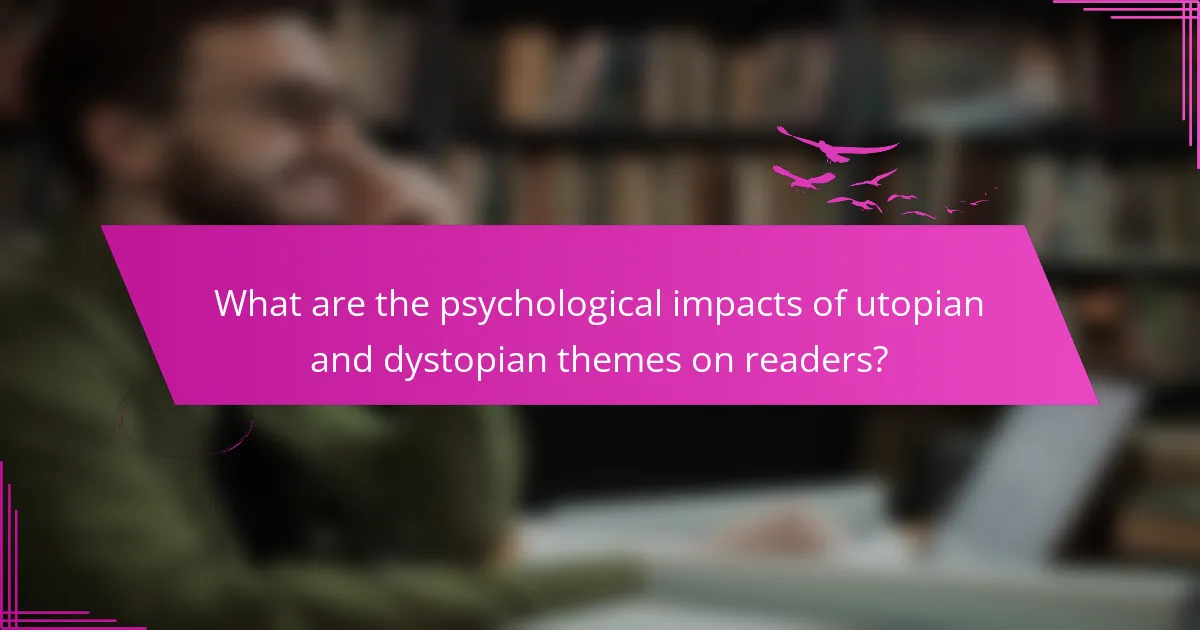
What are the psychological impacts of utopian and dystopian themes on readers?
Utopian and dystopian themes significantly influence readers’ psychological states. Utopian narratives often inspire hope and motivation, promoting positive ideals and visions of a better future. In contrast, dystopian stories provoke fear and anxiety, reflecting societal issues and potential consequences of current trends.
Readers may experience heightened emotional responses based on the themes presented. Utopian literature can lead to increased optimism, while dystopian works may foster critical thinking about societal structures. This dichotomy shapes readers’ worldviews and can motivate them to engage in social change or self-reflection.
The psychological impact varies among individuals, influenced by personal experiences and beliefs. Some may find solace in utopian ideals, while others resonate more with dystopian cautionary tales. This variance highlights the unique attributes of each reader’s engagement with these contrasting ideologies.
Overall, both utopian and dystopian themes serve as mirrors to society, impacting readers’ emotions and thoughts. Engaging with these narratives can lead to a deeper understanding of human nature and societal dynamics.
How do utopian narratives inspire hope and action?
Utopian narratives inspire hope and action by presenting idealized visions of society that motivate individuals to strive for positive change. These stories often highlight the potential for human progress, encouraging collective efforts toward a better future. Utopian themes can foster resilience, prompting communities to envision and work towards achievable goals. As a result, literature that embraces utopian ideals serves as a catalyst for social movements and innovation, reinforcing the belief that a harmonious society is possible.
In what ways do dystopian stories evoke fear and caution?
Dystopian stories evoke fear and caution by illustrating the consequences of societal failures. They often depict oppressive governments, loss of individuality, and environmental collapse. These narratives serve as warnings about the potential dangers of unchecked power and technological advancements. The unique attribute of dystopian literature lies in its ability to reflect contemporary anxieties, making the fear more relatable. As a result, readers are prompted to critically evaluate their own societal structures and values.
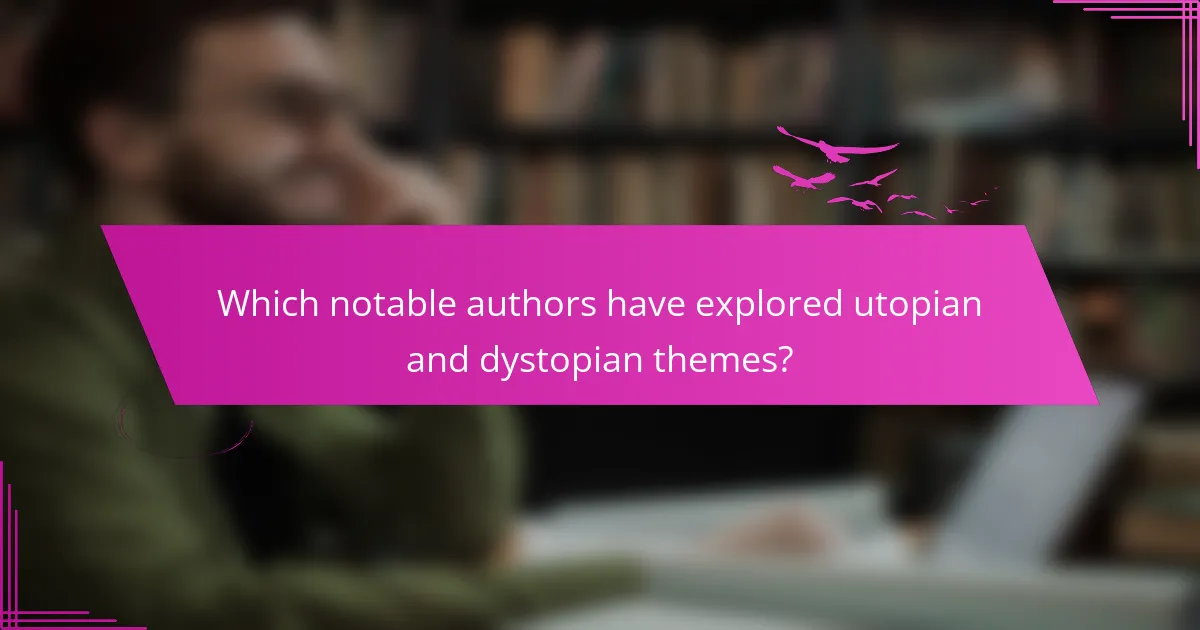
Which notable authors have explored utopian and dystopian themes?
Notable authors who have explored utopian and dystopian themes include George Orwell, Aldous Huxley, and Margaret Atwood. Their works illustrate contrasting ideologies, showcasing ideal societies versus oppressive regimes. Orwell’s “1984” presents a dystopian future dominated by totalitarianism, while Huxley’s “Brave New World” depicts a seemingly perfect society that sacrifices individuality. Atwood’s “The Handmaid’s Tale” explores themes of oppression and gender roles in a dystopian setting. These authors highlight the complexities of human nature and societal structures through their narratives.
What unique perspectives do contemporary authors bring to these ideologies?
Contemporary authors bring diverse perspectives to utopian and dystopian ideologies by exploring themes of technology, identity, and societal structure. They often challenge traditional narratives, presenting nuanced views on the consequences of idealism and pessimism. For example, authors like Margaret Atwood and Yuval Noah Harari examine how advancements in technology can lead to both utopian possibilities and dystopian realities. Their works reflect a unique attribute of blending speculative fiction with critical social commentary, encouraging readers to reconsider the balance between hope and caution in envisioning the future. This duality enriches literary discourse, making it relevant to current global challenges.
How do classic works compare to modern interpretations?
Classic works often emphasize idealistic visions, while modern interpretations frequently highlight dystopian themes. This shift reflects changing societal values and concerns. For instance, classic utopias like Thomas More’s “Utopia” depict harmonious societies, whereas contemporary works like “The Hunger Games” explore themes of oppression and inequality. This contrast illustrates how literature evolves to address current issues and fears, shaping reader perspectives on societal structures.
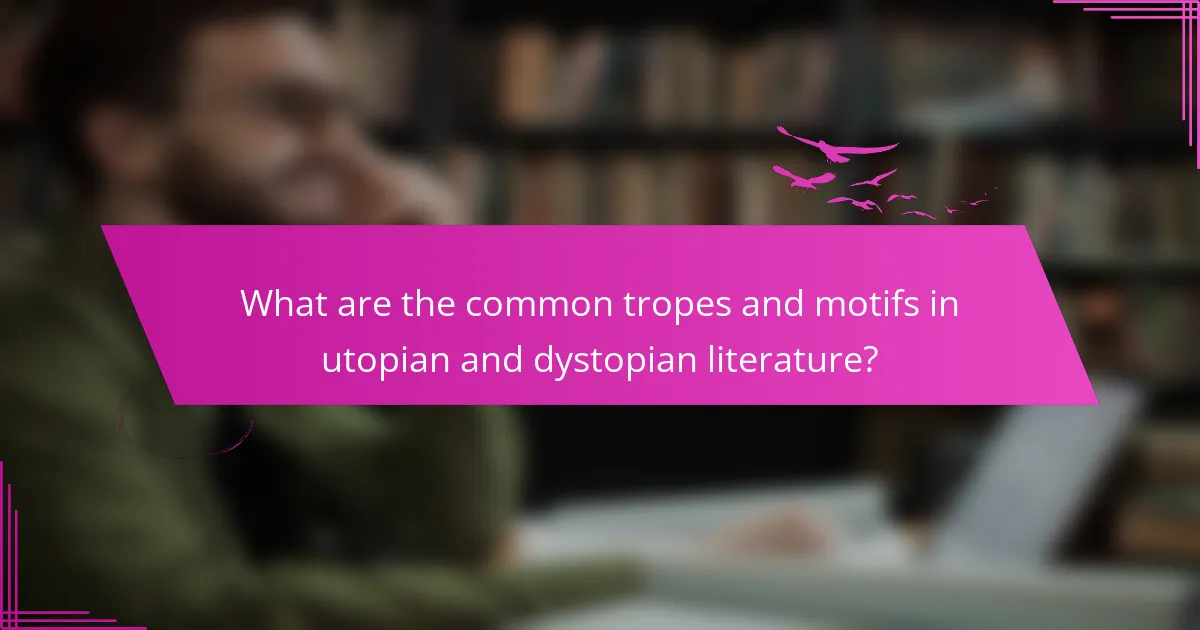
What are the common tropes and motifs in utopian and dystopian literature?
Utopian and dystopian literature often features contrasting tropes and motifs that reflect societal ideals and fears. Common tropes include the ideal society in utopian works versus oppressive regimes in dystopian narratives.
Utopian literature frequently highlights themes of harmony, equality, and technological advancement. Characters often embody hope and progress, creating a vision of a perfect world. In contrast, dystopian literature emphasizes control, surveillance, and societal decay. Protagonists typically resist authority, showcasing the struggle for freedom.
Motifs such as nature versus technology are prevalent. Utopian works may celebrate natural beauty and sustainability, while dystopian tales often depict environmental degradation. The use of language also varies; utopian texts promote positive communication, whereas dystopian narratives reveal manipulation and censorship.
These contrasting ideologies serve as a lens through which readers explore the complexities of human existence and societal structures.
How do settings and world-building differ between utopian and dystopian genres?
Utopian and dystopian genres differ in settings and world-building through their ideological foundations. Utopian settings often depict idealized societies with harmony, equality, and prosperity. In contrast, dystopian worlds reveal oppressive regimes, societal decay, and conflict. Utopian narratives emphasize hope and collective well-being, while dystopian tales explore fear and the consequences of human flaws. This contrast shapes character development and plot dynamics, influencing reader engagement with the themes of each genre.
What role do characters play in conveying ideological messages?
Characters play a crucial role in conveying ideological messages by embodying the themes of utopian and dystopian visions. They serve as vehicles for exploring societal ideals, fears, and critiques. Through their experiences and choices, characters illustrate the consequences of differing ideologies, prompting readers to reflect on their own beliefs. For example, a character in a dystopian narrative may represent the loss of individuality, while a character in a utopian story may embody hope and progress. This contrast highlights the complexities of human nature and societal structures, reinforcing the narrative’s ideological framework. Ultimately, characters deepen the reader’s understanding of the implications of these contrasting visions.
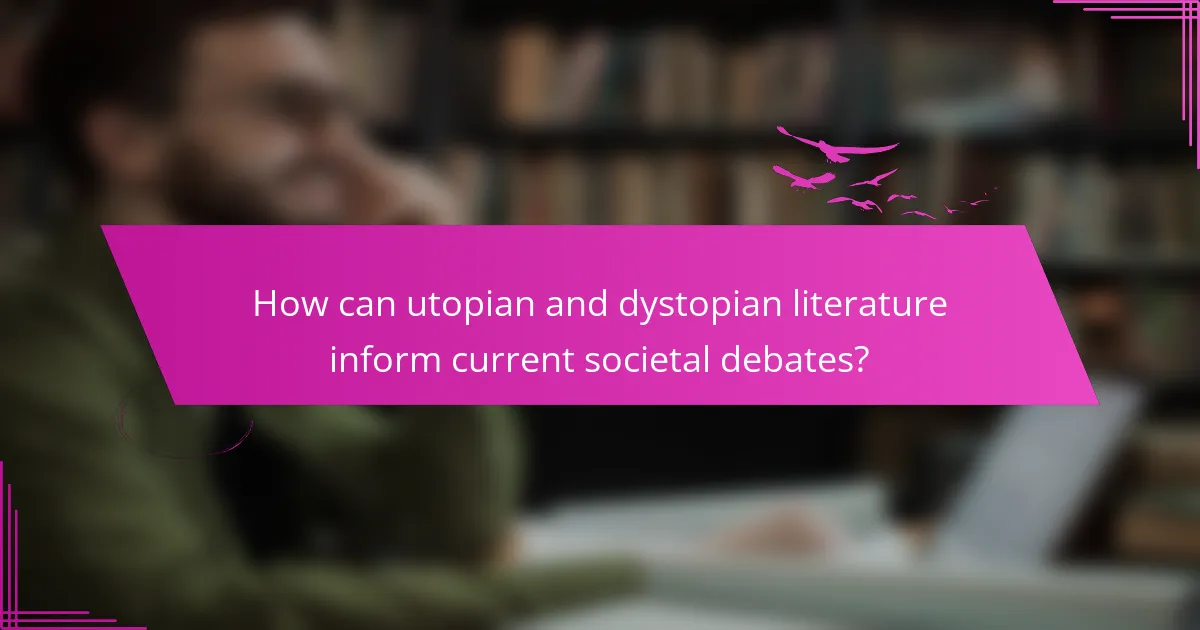
How can utopian and dystopian literature inform current societal debates?
Utopian and dystopian literature offers critical insights into contemporary societal debates by reflecting on human values and ethical dilemmas. These narratives challenge readers to consider the consequences of political ideologies, technological advancements, and social structures. Utopian visions often emphasize ideals like equality and harmony, while dystopian stories highlight the dangers of authoritarianism and social decay.
For example, works such as Aldous Huxley’s “Brave New World” and George Orwell’s “1984” serve as cautionary tales about the loss of individuality in oppressive regimes. Conversely, utopian texts like Thomas More’s “Utopia” propose alternative societal structures that promote collective well-being.
These contrasting ideologies stimulate discussions about current issues, such as surveillance, environmental sustainability, and social justice. By examining these themes, readers can better understand the implications of their choices and the direction of society. Ultimately, literature serves as a mirror, prompting reflection on the values that shape our world.
What lessons can be drawn from utopian visions in addressing global challenges?
Utopian visions offer innovative frameworks for solving global challenges by emphasizing collaboration and sustainability. These narratives inspire hope and motivate collective action, highlighting the importance of shared values. For example, literature often illustrates ideal societies that prioritize equity, environmental stewardship, and social justice. Such representations encourage real-world movements advocating for systemic change, demonstrating how aspirational ideas can drive progress.
How do dystopian narratives serve as warnings for future generations?
Dystopian narratives serve as warnings by illustrating potential consequences of societal flaws. They highlight issues like totalitarianism, environmental degradation, and loss of individuality. These stories provoke critical thinking about current social, political, and technological trends. For instance, George Orwell’s “1984” warns against surveillance and authoritarianism, while Margaret Atwood’s “The Handmaid’s Tale” critiques gender oppression. Such narratives encourage vigilance and inspire proactive measures to prevent negative outcomes. They resonate with readers, prompting reflection on the importance of safeguarding freedoms and ethical governance.
What are best practices for analyzing utopian and dystopian literature?
Analyzing utopian and dystopian literature requires a focus on contrasting ideologies and societal implications. Start by identifying the central themes and values within each genre. Examine character motivations and societal structures to uncover underlying messages. Analyze narrative techniques, such as tone and perspective, to understand how they shape reader perception. Consider historical and cultural contexts that influence the portrayal of ideal and flawed societies. Lastly, reflect on the implications of these visions for contemporary issues, encouraging deeper engagement with the material.
